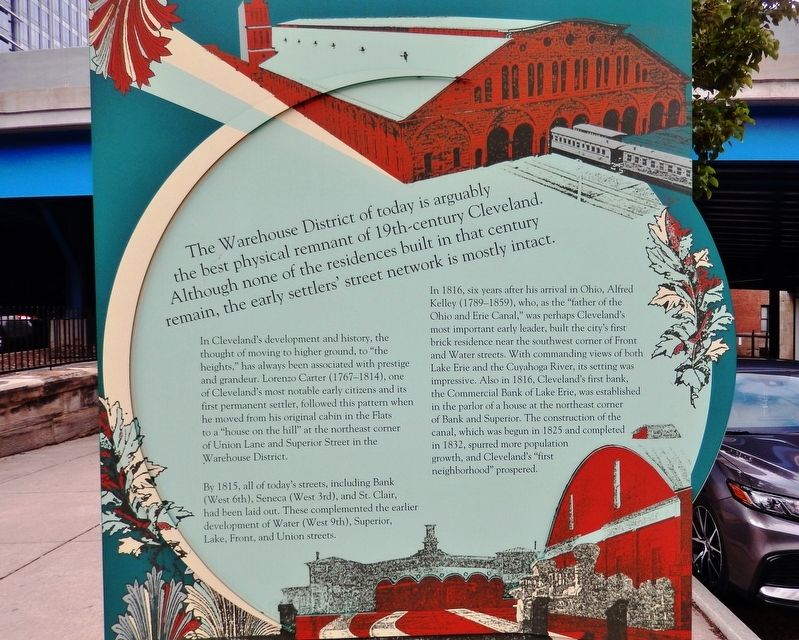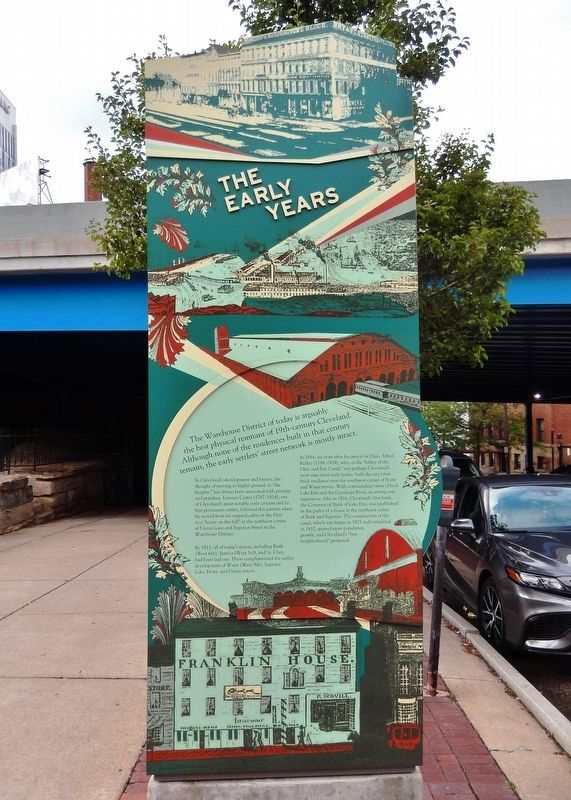Downtown in Cleveland in Cuyahoga County, Ohio — The American Midwest (Great Lakes)
The Early Years
Warehouse District Anthology
The Warehouse District of today is arguably the best physical remnant of 19th-century Cleveland. Although none of the residences built in that century remain, the early settlers’ street network is mostly intact.
In Cleveland's development and history, the thought of moving to higher ground, to "the heights," has always been associated with prestige and grandeur. Lorenzo Carter (1767-1814), one of Cleveland's most notable early citizens and its first permanent settler, followed this pattern when he moved from his original cabin in the Flats to a "house on the hill" at the northeast corner of Union Lane and Superior Street in the Warehouse District.
By 1815, all of today's streets, including Bank (West 6th), Seneca (West 3rd), and St. Clair, had been laid out. These complemented the earlier development of Water (West 9th), Superior, Lake, Front, and Union streets.
In 1816, six years after his arrival in Ohio, Alfred Kelley (1789-1859), who, as the "father of the Ohio and Erie Canal," was perhaps Cleveland's most important early leader, built the city's first brick residence near the southwest corner of Front and Water streets. With commanding views of both Lake Erie and the Cuyahoga River, its setting was impressive. Also in 1816, Cleveland's first bank, the Commercial Bank of Lake Erie, was established in the parlor of a house at the northeast corner of Bank and Superior. The construction of the canal, which was begun in 1825 and completed in 1832, spurred more population growth, and Cleveland's "first neighborhood" prospered.
Erected by The Warehouse District Development Corporation.
Topics. This historical marker is listed in these topic lists: Industry & Commerce • Roads & Vehicles • Settlements & Settlers • Waterways & Vessels. A significant historical year for this entry is 1815.
Location. 41° 30.03′ N, 81° 42.123′ W. Marker is in Cleveland, Ohio, in Cuyahoga County. It is in Downtown. Marker is on West 9th Street just north of West Lakeside Avenue, on the left when traveling north. Touch for map. Marker is at or near this postal address: 1220 West 9th Street, Cleveland OH 44113, United States of America. Touch for directions.
Other nearby markers. At least 8 other markers are within walking distance of this marker. Peter Weddell / Levi Johnson / Charles Otis (here, next to this marker); William Bingham (about 600 feet away, measured in a direct line); Hardware Industry (about 600 feet away); The Garment Industry (about 700 feet away); Independent Clothing Stores (about 700 feet away); Architectural Styles & Architects (approx. 0.2 miles away); The Warehouse District
(approx. 0.2 miles away); Liberty Enlightening the World (approx. 0.2 miles away). Touch for a list and map of all markers in Cleveland.
More about this marker. Warehouse District Anthology is a collection of stories that tell the history of Cleveland's first neighborhood. Like street level book pages, each freestanding element was designed by artist Corrie Slawson based on the District's history, curated and written by Thomas Yablonsky.
Regarding The Early Years. Cleveland Warehouse District, National Register of Historic Places #82003558 and #07000070.
Related markers. Click here for a list of markers that are related to this marker. Cleveland Warehouse District Anthology
Also see . . .
1. Lorenzo Carter.
Lorenzo Carter, frontiersman, community leader, and tavernkeeper, was Cleveland's first permanent settler, arriving in Cleveland on 2 May 1797. Until Apr. 1800, the Carters were the only white family in Cleveland, with other families who settled briefly there soon moving to Newburgh or Doan's Corners to escape the swampy environment. The Carters built a pretentious log cabin, used as an inn, with a garret, serving as a jail, on the east bank near the mouth of the Cuyahoga River.(Submitted on February 22, 2022, by Cosmos Mariner of Cape Canaveral, Florida.)
2. Alfred Kelley.
He came to Ohio in 1810 where he was admitted to the bar and appointed prosecuting attorney for Cuyahoga County. Kelley was the first president of the village of Cleveland (1815), member of the Ohio house of representatives, state senator, president of the Commercial Bank of Lake Erie (1816), and president of several railroad companies. As a member of the State Canal Commission, once he took up canal campaigning in 1823, the Ohio & Erie Canal dominated his life for several years.(Submitted on February 22, 2022, by Cosmos Mariner of Cape Canaveral, Florida.)
Credits. This page was last revised on February 4, 2023. It was originally submitted on February 21, 2022, by Cosmos Mariner of Cape Canaveral, Florida. This page has been viewed 91 times since then and 16 times this year. Photos: 1, 2. submitted on February 21, 2022, by Cosmos Mariner of Cape Canaveral, Florida.

